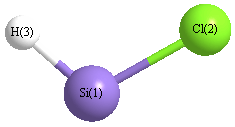Vibrational Frequencies calculated at MP2=FULL/6-311+G(3df,2p)
| Mode Number |
Symmetry |
Frequency
(cm-1) |
Scaled Frequency
(cm-1) |
IR Intensities
(km mol-1) |
Raman Act
(Å4/u) |
Dep P |
Dep U |
|---|
| 1 |
A' |
2091 |
1971 |
277.75 |
206.71 |
0.40 |
0.58 |
| 2 |
A' |
835 |
788 |
53.43 |
6.25 |
0.34 |
0.51 |
| 3 |
A' |
534 |
503 |
112.27 |
16.24 |
0.30 |
0.46 |
Unscaled Zero Point Vibrational Energy (zpe) 1729.8 cm
-1
Scaled (by 0.9427) Zero Point Vibrational Energy (zpe) 1630.7 cm
-1
See section
III.C.1 List or set vibrational scaling factors
to change the scale factors used here.
See section
III.C.2
Calculate a vibrational scaling factor for a given set of molecules
to determine the least squares best scaling factor.
